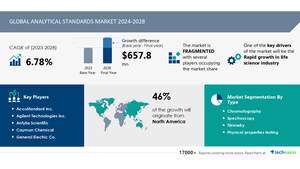NEW YORK, Oct. 8, 2024 /PRNewswire/ -- Report with market evolution powered by AI - The Logistics Market in Europe size is estimated to grow by USD 43.3 billion from 2024-2028, according to Technavio. The market is estimated to grow at a CAGR of 3.2% during the forecast period. Booming e-commerce industry in Europe is driving market growth, with a trend towards increasing customer-centric logistics. However, high cost of operation and competitive pricing poses a challenge - Key market players include AP Moller Maersk AS, BDP International Inc., Bertelsmann SE and Co. KGaA, Bollore SE, C H Robinson Worldwide Inc., CEVA Logistics, Deutsche Bahn AG, Deutsche Post AG, DSV AS, Expeditors International of Washington Inc., FedEx Corp., Hellmann Worldwide Logistics SE and Co KG, International Distributions Services plc, Kintetsu World Express Inc., Kuehne Nagel Management AG, Nippon Yusen Kabushiki Kaisha, Rhenus SE and Co. KG, SDK FREJA A S, SF Express Co. Ltd., and XPO Inc.
Key insights into market evolution with AI-powered analysis. Explore trends, segmentation, and growth drivers- View the snapshot of this report
Logistics Market In Europe Scope |
|
Report Coverage |
Details |
Base year |
2023 |
Historic period |
2018 - 2022 |
Forecast period |
2024-2028 |
Growth momentum & CAGR |
Accelerate at a CAGR of 3.2% |
Market growth 2024-2028 |
USD 43.3 billion |
Market structure |
Fragmented |
YoY growth 2022-2023 (%) |
3.07 |
Regional analysis |
Europe |
Performing market contribution |
Europe at 100% |
Key countries |
Germany, UK, France, Belgium, and Rest of Europe |
Key companies profiled |
AP Moller Maersk AS, BDP International Inc., Bertelsmann SE and Co. KGaA, Bollore SE, C H Robinson Worldwide Inc., CEVA Logistics, Deutsche Bahn AG, Deutsche Post AG, DSV AS, Expeditors International of Washington Inc., FedEx Corp., Hellmann Worldwide Logistics SE and Co KG, International Distributions Services plc, Kintetsu World Express Inc., Kuehne Nagel Management AG, Nippon Yusen Kabushiki Kaisha, Rhenus SE and Co. KG, SDK FREJA A S, SF Express Co. Ltd., and XPO Inc. |
Market Driver
Logistics providers in Europe are adopting innovative strategies to deliver customer-centric logistics solutions. They engage in discussions with clients about industry trends and challenges. The empowered consumer has necessitated a paradigm shift in supply chain management. Providers now consider historical orders, sales forecasts, weather forecasts, and customer sentiments to anticipate behavior. Predictive analytics is used to simulate and forecast future situations, enabling informed decision-making. Consumer-driven supply chains are aligning with demand variations, driving the growth of Europe's logistics market.
Logistics market trends encompass various industries like banking & financial services, media & entertainment, trade & transportation, and e-commerce. E-commerce companies prioritize timely delivery, leading to growth in last-mile logistics and route optimization. Multi-modal transportation, including airways, waterways, railways, and roadways, is crucial for efficient supply chain networks. Trade-related activities, such as container trade and free trade agreements, impact logistics significantly. Defense manufacturing, petroleum, food products, and oil & gas industries rely on logistics for transportation of goods. Digital transformation through AI, IoT, AR, and blockchain enhances logistics monitoring systems. Outsourced and third-party logistics services are in demand for inventory management and warehousing. E-commerce activities and online purchases require logistics solutions, focusing on green solutions for sustainability. Transportation infrastructure development is essential for accommodating increasing logistics demands.
Request Sample of our comprehensive report now to stay ahead in the AI-driven market evolution!
Market Challenges
- The European logistics market is characterized by complex supply chains, with most products originating from Asian manufacturing locations. These goods are transported via air, ocean, or rail to European distribution centers for final delivery. The total logistics costs have risen due to longer or more intricate supply chains. A typical European supply chain consists of shipping from manufacturing locations, trucking from ports, reception and storage at distribution centers, and sales order fulfillment and final distribution. Inefficient packaging can negatively impact all elements of the supply chain. In the rail sector, high capital costs, particularly in Southern and Eastern Europe, and fuel costs, which account for over 25% of the industry's collective cost base, pose significant challenges. Port-to-port shipping and customer deliveries often incur the most costs in international supply chains, with additional expenses including personnel costs, fuel costs, and other variable costs. The logistics market in Europe faces the dual challenges of high operating costs and competitive pricing during the forecast period.
- Logistics market is facing numerous challenges in today's business environment. With online purchases, efficient and reliable delivery solutions are essential. Roadways remain the backbone of transportation, but infrastructure improvements are needed to handle increasing e-commerce activities. Green logistics solutions are crucial to reduce carbon footprint, with technologies like AI, IoT, and AR playing key roles. Logistics monitoring systems, blockchain, and sensor technologies ensure transparency and accuracy in supply chain networks. Waterways transportation offers cost-effective alternatives to roadways for heavy goods. Third-party and second-party logistics, outsourcing, and logistics standardization are shaping the industry. Industries like healthcare, pharmaceuticals, manufacturing, and aerospace have unique logistics requirements. Tech-driven logistics, multi-modal systems, and IoT-enabled devices are revolutionizing transportation. Last-mile deliveries and logistics automation are critical for retail success. Military logistics, reverse logistics operations, and trade agreements also impact the market. Overall, the logistics landscape is evolving rapidly, requiring continuous innovation and adaptation.
Discover how AI is revolutionizing market trends- Get your access now!
Segment Overview
This logistics market in Europe report extensively covers market segmentation by
- Type
- 1.1 3PL
- 1.2 4PL
- End-user
- 2.1 Manufacturing
- 2.2 Automotive
- 2.3 Consumer goods
- 2.4 Retail industry
- 2.5 Others
- Geography
- 3.1 Europe
1.1 3PL- Third-party logistics (3PL) is a business process where companies outsource their logistics functions to specialized service providers. In Europe, 3PLs have become essential for improving logistics effectiveness by introducing innovative supply chain management techniques. Three primary types of 3PL exist: asset-based, management-based, and integrated providers. Asset-based companies use their private vehicles, warehouses, and employees, while management-based providers deliver technological and managerial support. Integrated providers offer a combination of both. 3PL services encompass transportation, warehousing, distribution, freight forwarding, inventory management, and packaging. They tailor solutions to meet individual client needs, optimizing routes, reducing costs, and enhancing operational efficiency. In the European context, 3PLs facilitate cross-border trade and overcome logistical challenges. They offer flexibility to scale operations based on demand fluctuations, supporting seasonal peaks and market expansions. Technology adoption is a hallmark of modern 3PLs, providing real-time tracking, data analytics, and visibility tools. The Russia-Ukraine conflict in 2022 disrupted various aspects of the European logistics market. Transportation routes were affected, leading to delays, rerouting, and blockades. Supply chain disruptions caused shortages, forcing manufacturers to halt production or incur significant cost increases. Increased logistics costs due to rerouting and alternative transportation modes, as well as fuel price and insurance premium fluctuations, strained logistics budgets. Geopolitical tensions influenced foreign trade relationships, creating complexities for cross-border trade planning and forecasting. Despite these challenges, the use of 3PL services will continue to drive the growth of the 3PL segment in the European logistics market, enabling companies to remain competitive in a complex business landscape.
Download a Sample of our comprehensive report today to discover how AI-driven innovations are reshaping competitive dynamics
Research Analysis
The global logistics market is a dynamic and evolving industry that encompasses various modes of transportation, including roadways, and caters to diverse sectors such as e-commerce, trade-related activities, defense manufacturing, petroleum, food products, and more. With the rise of online purchases, there is a growing demand for efficient and reliable logistics solutions. Green logistics solutions are gaining popularity due to increasing environmental concerns, while logistics monitoring systems, blockchain, artificial intelligence, the Internet of Things, and augmented reality are revolutionizing the industry. Logistics management and supply chain management are crucial aspects of the market, with Fourth-Party Logistics, inbound logistics, outbound logistics, reverse logistics, and digital logistics playing significant roles. Military logistics and reverse logistics operations are essential for defense manufacturing and ensuring the smooth functioning of armed forces. Last-mile delivery, route optimization, and transportation systems are also vital components of the logistics market. Free trade agreements and trade-related activities further impact the industry's growth and development.
Market Research Overview
The logistics market is a dynamic and complex ecosystem that encompasses various modes of transportation, technologies, and industries. At its core, logistics facilitates the efficient movement of goods and services from one place to another. In today's digital age, the logistics industry is undergoing a significant transformation. Online purchases have led to an increase in e-commerce activities, necessitating the need for efficient last-mile deliveries and logistics automation. Green logistics solutions are gaining popularity as businesses strive to reduce their carbon footprint. Logistics monitoring systems, including Blockchain, Artificial Intelligence, and the Internet of Things, are revolutionizing supply chain management and inventory management. Sensor technologies and Augmented Reality are being used to optimize transportation infrastructure and improve warehouse management systems. The logistics market caters to various industries, including manufacturing, healthcare, pharmaceuticals, retail, and aerospace, among others. Third-party and second-party logistics, outsourcing, and logistics standardization are common practices in the industry. The use of multi-modal systems, including roadways, waterways, airways, and railways, enables efficient transportation of goods. Trade agreements, tech-driven logistics, and digital transformation are shaping the future of the logistics industry. IoT-enabled devices, route optimization, and timely delivery are essential components of a successful logistics strategy. The defense manufacturing, oil & gas, food products, and semiconductor industries rely heavily on logistics to ensure the timely delivery of critical components and finished products. In conclusion, the logistics market is a critical component of the global economy, enabling businesses to efficiently move goods and services across various industries and modes of transportation. The integration of technology and digital transformation is driving innovation and efficiency in the logistics industry, making it an exciting and dynamic field to watch.
Table of Contents:
1 Executive Summary
2 Market Landscape
3 Market Sizing
4 Historic Market Size
5 Five Forces Analysis
6 Market Segmentation
- Type
- 3PL
- 4PL
- End-user
- Manufacturing
- Automotive
- Consumer Goods
- Retail Industry
- Others
- Geography
- Europe
7 Customer Landscape
8 Geographic Landscape
9 Drivers, Challenges, and Trends
10 Company Landscape
11 Company Analysis
12 Appendix
About Technavio
Technavio is a leading global technology research and advisory company. Their research and analysis focuses on emerging market trends and provides actionable insights to help businesses identify market opportunities and develop effective strategies to optimize their market positions.
With over 500 specialized analysts, Technavio's report library consists of more than 17,000 reports and counting, covering 800 technologies, spanning across 50 countries. Their client base consists of enterprises of all sizes, including more than 100 Fortune 500 companies. This growing client base relies on Technavio's comprehensive coverage, extensive research, and actionable market insights to identify opportunities in existing and potential markets and assess their competitive positions within changing market scenarios.
Contacts
Technavio Research
Jesse Maida
Media & Marketing Executive
US: +1 844 364 1100
UK: +44 203 893 3200
Email: [email protected]
Website: www.technavio.com/
SOURCE Technavio

WANT YOUR COMPANY'S NEWS FEATURED ON PRNEWSWIRE.COM?
Newsrooms &
Influencers
Digital Media
Outlets
Journalists
Opted In





Share this article